🧠 AP Psychology Unit 2: Cognition
2.1 Perception
perception is the process of organizing and interpreting the information we obtain through our senses
sensation is about detecting a stimulus
perception is about interpreting a stimulus
top-down processing: perception is conducted using prior experiences and expectations to interpret the sensory input
used when a stimulus is familiar or simple
helps us process things in a efficient manner, but may cause the brain to overlook small details
proofreader’s illusion - failure to notice errors when reading typed materials
ex.) missing typos when skimming through a paper
leads to skewed perceptions as our previous experiences and expectations influence the interpretation of new stimuli
bottom-up processing: when the stimuli or experience is complex and unfamiliar to the individual, perception starts at sensory receptors and works up to higher levels of processing
perception is built from the ground up as we organize and interpret information as it comes in without relying on prior knowledge.
takes longer than top-down processing
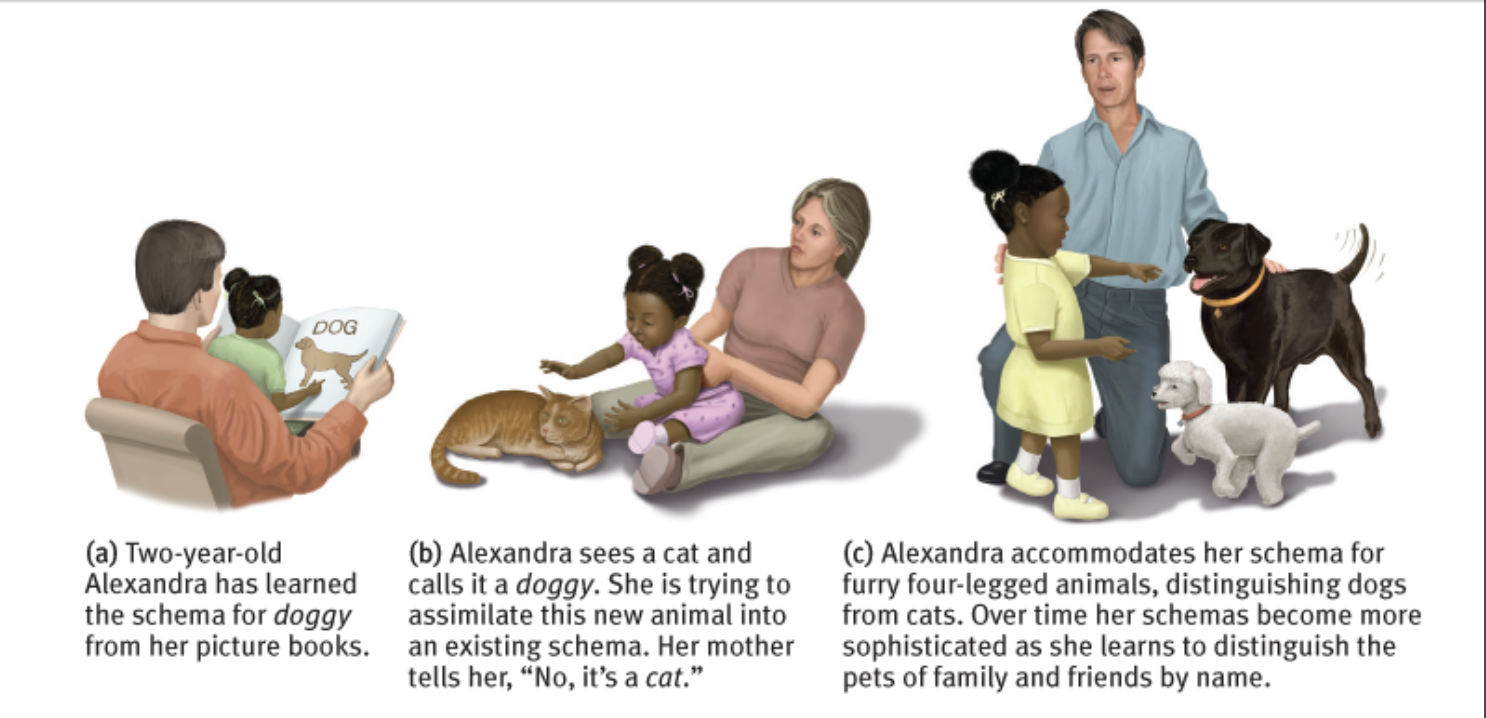
schemas: mental framework that organizes and builds on our past experiences
helps us predict and interpret experiences, but must be changed to accommodate for new experiences
perceptual sets: a mental predisposition to perceive one thing and not another
schemas and perceptual sets can be beneficial for efficient processing, but can lead us astray based on various moods
perception can be influenced by both internal factors (such as culture, mood, emotions, and expectations) and external factors (environment)
selective attention: when we focus on a particular stimulus, we often tune out other stimuli in our environment to focus on relevant information
ex.) focusing on a conversation even if loud music is playing in the background
manage sensory inputs to give priority to what’s important while filtering out unnecessary stimuli
cocktail party effect: ability to focus on a specific conversation or sound in a noisy setting
in-attentional blindness: the failure to notice stimuli in our visual field due to our attention being focused elsewhere
change blindness: a type of inattentional blindness where we fail to notice changes in the environment
these phenomenons demonstrate the limitations and selective nature of human attention
apparent movement: the perception of motion despite nothing actually moving
phi phenomenon: occurs when lights blink on and off in sequence, resulting in the perception of objects as moving even though the objects are stationary
induced movement: occurs when a stationary object appears to move because of the motion of surrounding objects
gestalt psychology: focuses on how humans naturally group elements together to form meaningful patterns
helps explain how we organize our perceptual world
do not process brain as individual stimuli, instead as a unified whole
emphasizes that our perceptual experiences are more than the sum of their parts
gastal principles: explain how we naturally organize sensory input into meaningful patterns
proximity: when objects are placed close to each other they are often perceived as a single group, while objects that are spaced farther apart are seen as separate entities
similarity: explains how we perceive a group of similar objects or patterns as one cohesive unit (anomalies stand out)
closure: our brain subconsciously fills in missing information when viewing a familiar but incomplete object
figure & ground: describes how our visual system separates what we see into two categories; figure, the object of focus, and the ground, the background
symmetry: when objects that are symmetrical to each other are perceived as one object, rather than individual, separate elements
continuation: addresses why our eyes naturally follow continuous lines or paths
ex.) drawn to the door upon seeing exit signs

depth perception: the ability to perceive relative distance of an object in one’s visual field
binocular depth cues: a depth cue that depends on the use of two eyes
retinal disparity: by comparing retinal images from two eyes, the brain perceives depth
the greater the disparity, the closer the object
convergence: the extent to which the eyes converge inward when looking at an object, the closer the object is
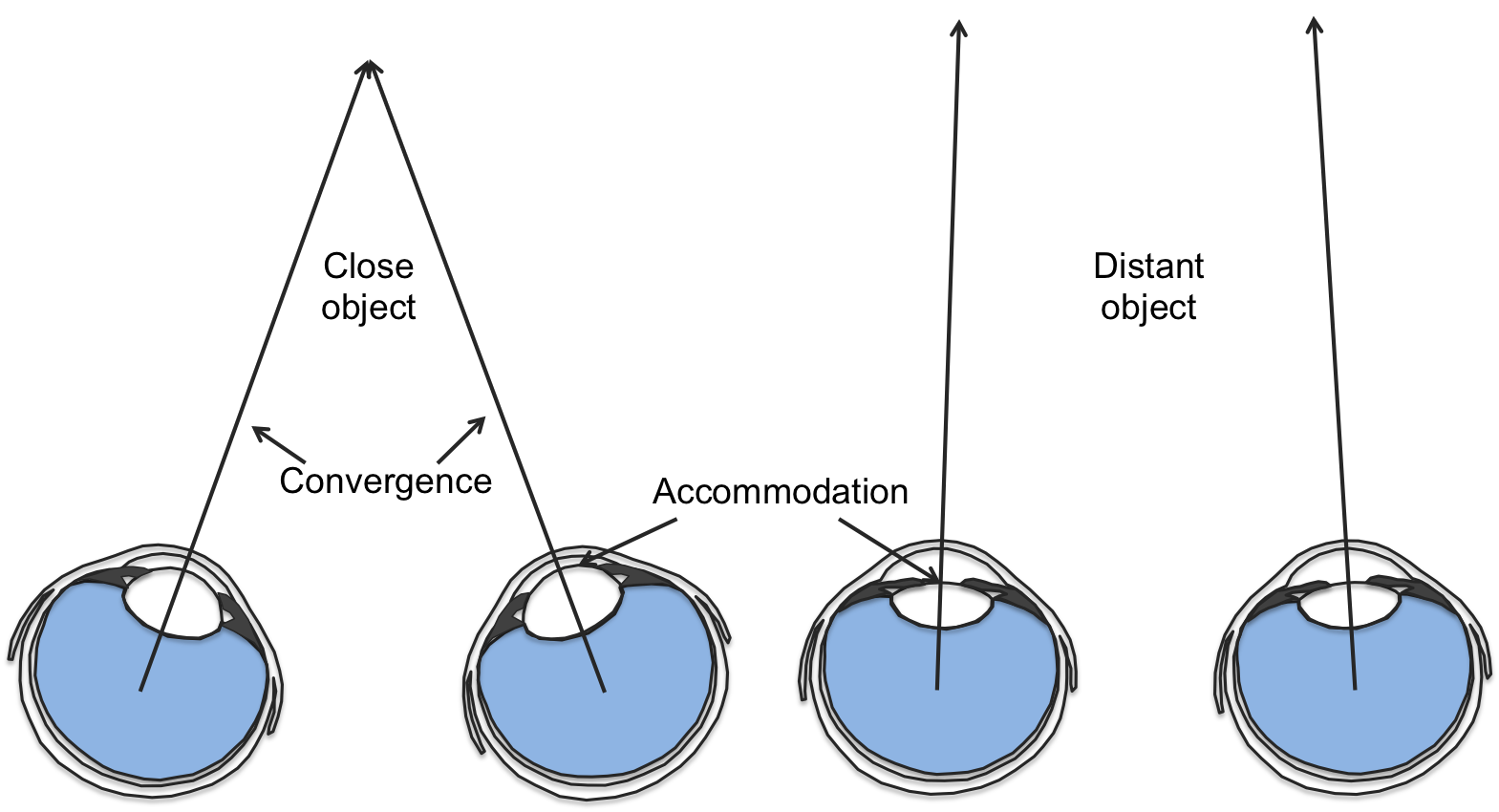
monocular depth cues: a depth cue available to either eye alone
ex.) interposition or linear perspective
perceptual constancy: ability to perceive objects as having a consistent shape, size, color, and lightness, even when their appearance change due to varying conditions
size constancy: brain’s tendency to perceive objects as the same size
color constancy: when we perceive the color of an object to remain consistent, even if the lighting changes
shape constancy: tendency of the brain to perceive an object’s shape as the same, even when it moves
ex.) opening and closing a door
lightness constancy: the ability to perceive the blackness, whiteness, and grayness of an objective as consistent even under different lighting conditions, essentially this is the shading of an object
constancies explain why the brain doesn’t perceive someone to grow bigger when approaching or coloring drastically changing in a dark versus lit room
2.2 Thinking, Problem-Solving, Judgements, & Decision-Making
cognition: how we use and store information
ex.) perceiving, judging, remembering, conceiving, reasoning, imagining, and problem-solving
humans are wired to think a certain way —> shortcuts and biases
metacognition - essentially thinking about thinking
ex.) if studying for a test, you plan out how the methods you will use to best remember the information
concepts: mental categories that help us organize and understand the world
group objects, events, ideas, and people under a shared classification
prototypes: most typical or basic example of a concept, it serves as a mental image that illustrates the concept and acts as a cognitive reference point or benchmark
when asked to name a bird cardinals and blue jays (flying birds) are more likely to be your prototype than a flamingo or ostrich
if asked to name balls used in a sport, ball is the concept and specific examples are prototypes
schemas: more complex mental frameworks that organize and interpret information about the world
they help us categorize new information and experiences based on previous knowledge, allowing for quicker understanding and decision-making
assimilation: when we fit new information into existing schemas
accommodation: when a schema is changed to incorporate new information
helps individuals consistently refine and expand their schemas → better understanding of their experiences and the world
assimilation adds information without altering the schema while accomodation alters the schema to add information
problem-solving strategies
executive functioning: cognitive processes that help individuals organize, plan, and carry out goal-directed behaviors (in addition to engaging in critical thinking)
closely linked to the frontal lobe and prefrontal cortex
trial and error: repeating trials and learning from each error
insight learning: sudden realization of how to solve a problem, often after trial and error
algorithms: where a person tackles a problem step-by-step in a systematic way
ex.) upon losing your phone, search every room in your home; math class
heuristics: mental shortcuts based on past experiences that reduce mental effort needed to make decisions, simplify complex questions, fast way to arrive at a conclusion, and help with problem-solving
ex.) upon losing your phone, retrace your steps and focus on the areas where you had your phone
saves time but may lead you to miss areas
representative heuristics: involves making judgements based on how much something resembles or represents a typical case or stereotype
could cause individuals to overlook details and focus on information that aligns with their expectations/biases
availability heuristics: involves making judgements based on how easily examples come to mind
could lead to errors when decisions are influenced heavily on recent memories instead of a full consideration of the facts

mental set: a cognitive framework that relies on past experiences and successful strategies to solve new problems
specific to problem-solving while a schema is focused on organizing information
when approaching new challenges in life, people are more likely to approach it using methods that worked in the past
saves time and energy, but limits creativity and prevents from considering better or more efficient solution
mental set is intended for problem solving while schemas interpret and organize past information
priming: the phenomenon where exposure to one stimulus influences how we respond to a later stimulus
repetition priming: occurs when exposed to a specific stimulus that makes it easier to recognize that same or similar stimulus later
semantic priming: involves the influence of one word on the interpretation of another, related word
framing: refers to how information is presented, which can shape how we interpret and react to it, often influencing our decisions and judgments
creativity: when individuals create new ideas or solutions
divergent thinking: when a person explores many possible solutions, expanding the range of options for solving a problem
How can we improve this product?
not one correct solution, start from one question —> multiple solutions
convergent thinking: involves narrowing down the possibilities to come up with the single best option
ex.) only one correct solution to a math problem
Sternberg’s five key components of creativity -
expertise: the more knowledge one has about a subject, the more likely they are to apply it in new and innovative ways
intrinsic motivation: individuals must have an internal drive to pursue a goal for personal satisfaction, rather than external rewards
venturesome personality: the individual must be willing to seek out new experiences and embrace challenges that will help them grow and see new perspectives
creative environment: individuals that surround themselves with other creative people and and creative environments tend to foster innovation and promote creative thinking
imaginative thinking: an individual must be able to view concepts in a unique and creative way, rather than focusing on traditional perspectives
people become limited by one way of thinking
functional fixedness: limits an individual to using an object only in its traditional way
ex.) thinking of a as hammer only a tool for pounding nails, not a doorstop
cognitive biases
gambler’s fallacy: mistaken belief that if an event occurs more frequently than normal during a given period, it will happen less frequently in the future, or vice versa
ex.) if roulette keeps landing on red 10 times, might believe 11th will be black (no effect on future spins)
—> poor decision making
sunk-cost fallacy: tendency to continue to pursue an action in which you’ve already invested money, time , or resources into, regardless of its future value
ex.) business is failing, keep investing because of already resources put in, not wanting those investments to go to waste
keeps individuals stuck in unproductive situations
2.3 Introduction to Memory
Memory is the persistence of learning over time through the encoding, storage, and retrieval of information.
3 process that occur in the memory system
encoding: the process of placing information into the memory system
storage: the process of retaining information over time (if encoded properly)
retrieval: the process of getting information out of memory storage
The better information is encoded, the better it will be able to be retrieved from storage
recall: retrieving information that is not currently in your conscious awareness but that was learned at an earlier time.
ex.) fill in the blank questions
recognition: identifying items previously learned
ex.) multiple choice question
relearning: learning something quicker when you learn it a second time
when you study for a final exam or engage a language used in early childhood, you will relearn the material more easily than you did initially.
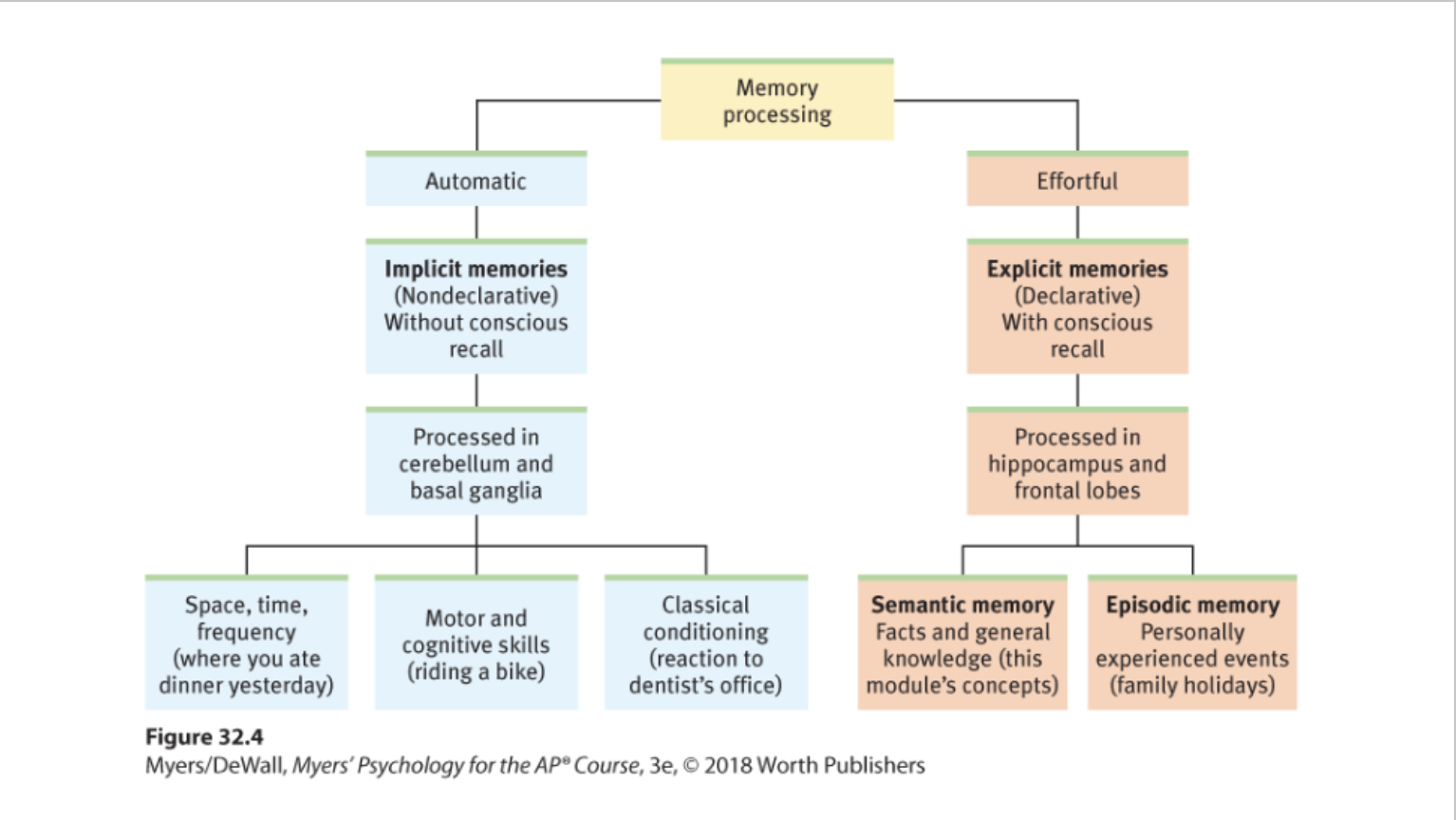
Attkinson-Shiffrin model : states that there are three distinct types of memory, each with its own function
sensory memory: stores all incoming sensory information for up to a second
no attention —> forgotten
short-term memory: what is occuring in the present moment, lasts for 2-30 seconds (also referred to as working memory)
not encoded —> forgotten
hold 5-9 things in your short-term memory
long-term memory: lasts forever
if something is encoded for storage properly, it can theoretically last forever (without suffering brain damage)
long-term potentiation (LTP): process that strengthens the synaptic connections between neurons in the brain through repeated activation
explicit memory: involves information that we consciously recall, requiring more effort and thought
episodic memory: related to personal experiences and events
semantic memory: involves knowledge and facts
implicit memory: information or skills we learn without being fully aware of it
procedural memory: helps us recall how to perform tasks, such as motor skills and routines
prospect memory: involves remembering to perform future actions
ex.) recalling to take a medication at a specific time or attending a meeting next week
parallel processing: brain handles multiple streams of information simetanuelosy
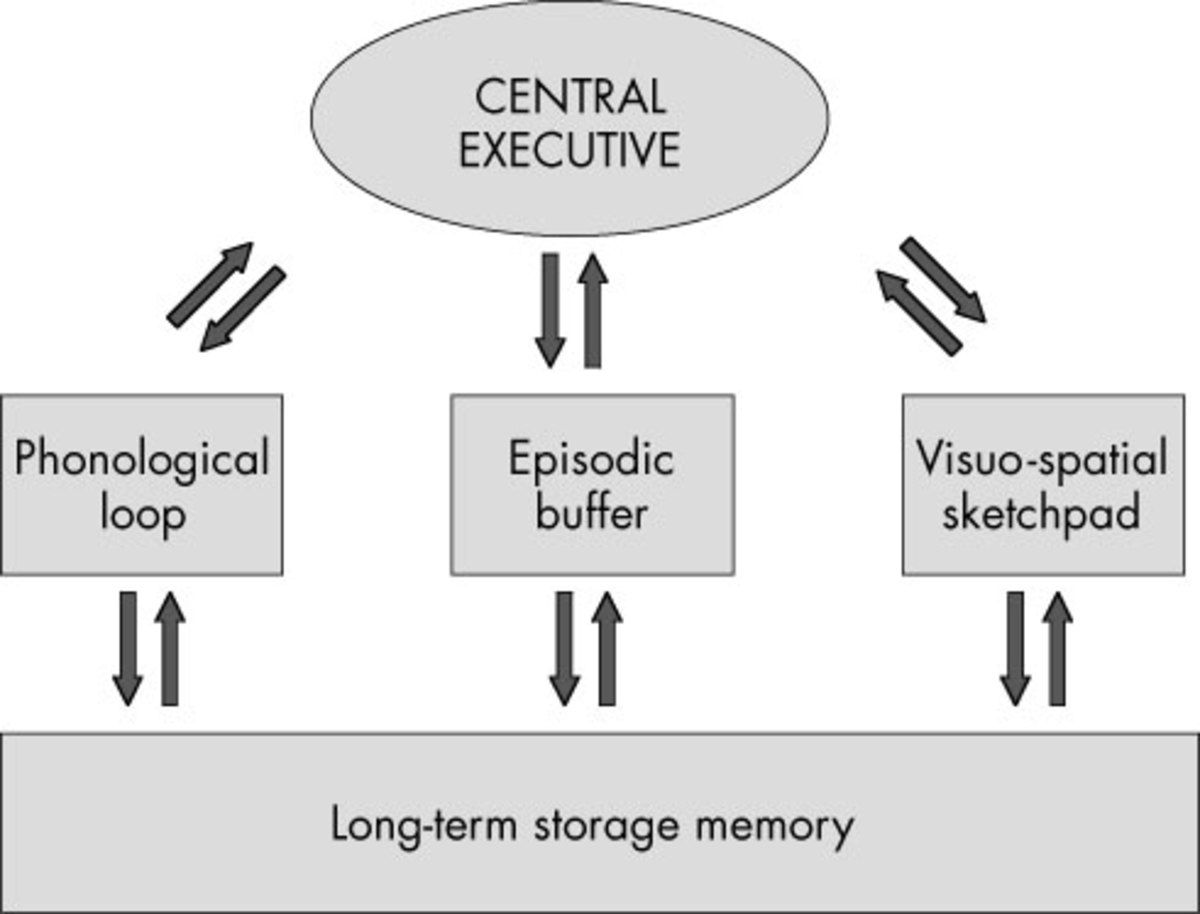
working memory model: explains how our primary memory system (working memory) processes and temporarily holds information for cognitive tasks
central executive: acts as the control center of working memory by focusing attention, prioritizing tasks, switching between different activities, and integrating information from the loop and sketchpad
visuospatial sketchpad (aka the inner eye): handles visual and spatial information, allowing us to visualize objects and their locations
ex.) imagining furniture in a room or a scene in a book
phonological loop: deals with verbal and auditory information
phonological store (aka inner ear): holds spoken words and sounds for a short period of time
articulatory rehearsal process (aka inner voice): helps you repeat and rehearse verbal information to keep it active in your working memory
ex.) keeping a list of words in mind or remembering a phone number long enough to dial it
episodic buffer: explains how long-term memory integrates with working memory and how different types of information, such as sounds and visuals, are combined
acts as temporary storage system that brings together information from the phonological loop, visuospatial sketchpad, and long-term memory into one cohesive sequence

multi-store model: explains how information is processed, stored, and retrieved, focusing on three key systems that information must pass through if it is going to be remembered
Stimulus —> Sensory Memory —> Working Memory —> Long-term memory
sensory memory: very brief recording of sensory information in the memory system
automatic processing takes place here, meaning information is gathered with little or no conscious effort
iconic memory: visual sensory memory that lasts for a fraction of a a second
ex.) you can see the afterglow of a sparkler
echoic memory: auditory sensory memory that lasts 1-4 seconds
ex.) somebody asks for question but you didn’t catch, go back into the echoic memory to retrieve
if your attention is caught, information moves into working/short-term memory
information can be lost easily, but rehearsal can be used to keep it fresh
rehearsal: encoding information but repeatedly practicing it
two types: maintenance (repeating info to prevent forgetting) & elaborative (connect old information to new information)
levels of processing: shallow and deep
encoding: process of moving information from short-term to long-term memory
retrieval: pull information out of storage
structural processing: superficial level, focus on the physical appearance
ex.) what a word looks like
phonemic processing: deeper level, focus on how the information sounds
ex.) how a word is pronounced
semantic processing: deepest level, focus on the meaning of the information
ex.) understanding of a word’s definition
2.4 Encoding Memories
encoding: the process and strategies we use to take in information and store it in our long-term memory
visual encoding: encoding information by observed visual elements
ex.) noticing certain sections of a book have a specific font
acoustic encoding: when the different sound elements help with the encoding process
ex.) remember information by using rhymes
tactile encoding: using the feeling of touch when encoding information
ex.) remembering the texture of an object
organizational encoding: processing information in terms of a specific sequence
this can take the form of lists, groups, or the focus between relationships
elaborative encoding: pairing new information with prior knowledge
semantic encoding: focusing on the meaning or context of the information
used with deep processing, one of the most effective encoding methods
shallower processing is linked with weaker memory retention, while deep processing is the most effective for recall
mnemonic devices help organize information and make it easier to recall
ex.) acronyms, visual images, associations, and rhymes
Method of Loci: mentally visualize and place items in a familiar room
ex.) visualize the presidents in your bedroom
uses spatial memory and vivid imagery to enhance recall
chunking: involves grouping individual pieces of information into a larger, more manageable unit
organizing information into categories or hierarchies helps the brain create connections between related concepts, making it easer to store and retrieve the information later on
the spacing effect: the tendency for distributed practice to yield better long-term retention than massed practice because it allows brain to better encode information

serial position effect: order of learning information determines how well the information will be more remembered
primacy effect: information learned early will be remembered because more time to process
recency effect: information learned later on will be remembered because it is still in the working memory
middle set of information is often forgotten as it receives less rehearsal time
2.5 Storing Memories
four stages of memory:
sensory memory: briefest form of memory, captures a lot of sensory information, but only for a few seconds
location of the iconic and echoic memories
short-term memory: typically holds around seven items at a time and usually for only twenty to thirty seconds
working memory: a more updated dynamic form of the short-term memory stores and processes information
plays critical role in managing information
long-term memory: has an unlimited capacity and stores information for long periods of time
includes learned information like facts, experiences, and skills
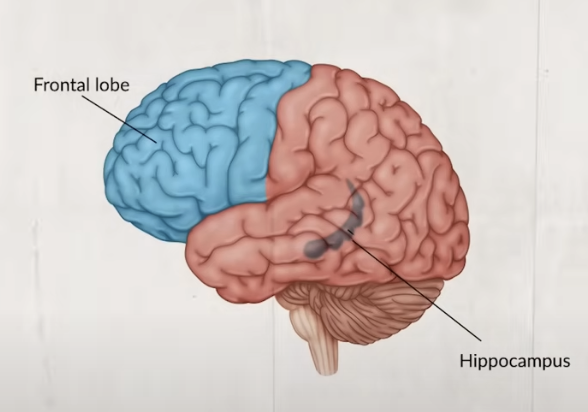
frontal lobe stores explicit memories while hippocampus processes and stores temporary information before it is sent to different areas of the brain
memory consolidation: a process by which short-term memories are transformed into long-term memories
information is solidified and neuro-connections in the brain are strengthened —> easier to recall later on
often occurs during sleep
cerebellum and basal ganglia play a critical role in forming and storing implicit memories
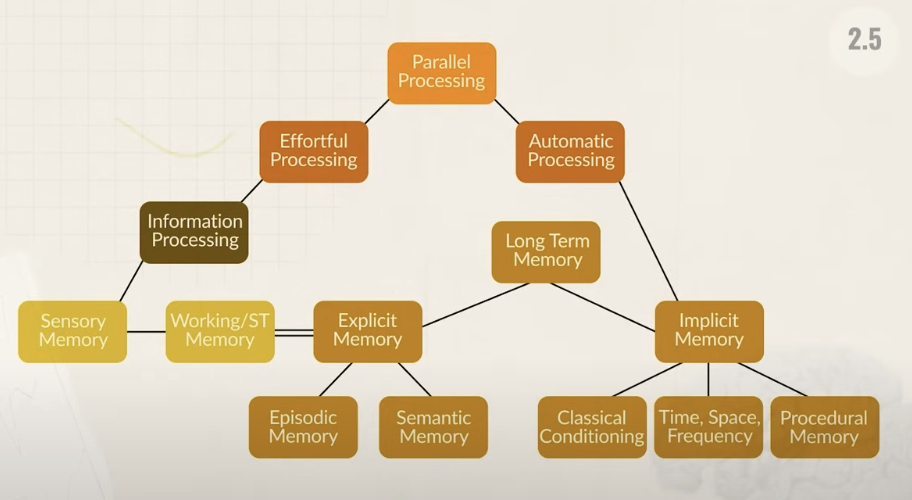
there are two distinct memory systems: effortful and automatic processing
emotions influence the creation and storage of memories
the body releases hormones that promote the creation of memories
flashbulb memories: very detailed memories that are often formed around events that are extremely stressful, traumatic, or emotional
autobiographical memory: involved memories connected to our own lives that are generally more memorable because of the personal relevance these memories have
individuals with highly superior autobiographical memories hold extremely detailed, and accurate, recollections of their experiences
brain damage can result in memory loss
this be caused by physical damage, developmental limitations, and diseases
damage to the hippocampus can lead to trouble recalling explicit memories
damage to the left hippocampus often results in individuals struggling to remember verbal information
damage to the right hippocampus often results in individuals struggling to remember visual information
amnesia: the temporary or permanent loss of memory
retrograde: an individual can no longer retrieve past information
can occur due to a head injury
anterograde: an individual can no longer form new memories
almost always involves damage to the hippocampus
source: an individual can remember information but is unable to recall where or how they learned it
infantile: an adult cannot remember personal experiences from the early years of life
memories from infant and toddler years fade as individuals age because the brain was underdeveloped when these memories were initially formed
alzheimer’s disease: a neurodegenerative disorder that impairs memory and cognitive functions of an individual
disrupts storage and retrieval of both new and old memories
2.6 Retrieving Memories
memory retrieval: accessing memories that have been in storage
two forms of retrieval:
recall: retrieving information without any cues or hints, relies solely on the internal memory
ex.) giving out a phone number (no retrieval cues present)
recognition: using retrieval cues to help access the information
ex.) recognizing the correct option on a multiple-choice exam
the memory retrieval process can be influenced by an individual’s environment, mood, and physical state
memory recall can be enhanced when the conditions during recall match the conditions present during the encoding of a memory
context-dependent memory: retrieval is improved when an individual’s environment is the same as when the information was first learned
mood-congruent memory: an individual is more likely to recall memories that match their current mood
ex.) when happy or sad, it is easier to recall positive or negative memories
state-dependent memory: memory retrieval is improved if an individual is in the same mental or physical state as when the memory was encoded
ex.) when ill, it is easier to recall past memories of being sick in past
associating new information with old information strengthens retrieval cues and the likelihood of successful retrieval
ex.) learning classmate’s names based on where they sit in class, their hair color, or any shared interests
practicing metacognition can improve retrieval processes
reflecting on learning and thinking processes allows you to recognize when you truly understand and what you are struggling with
2.7 Forgetting and Other Memory Challenges
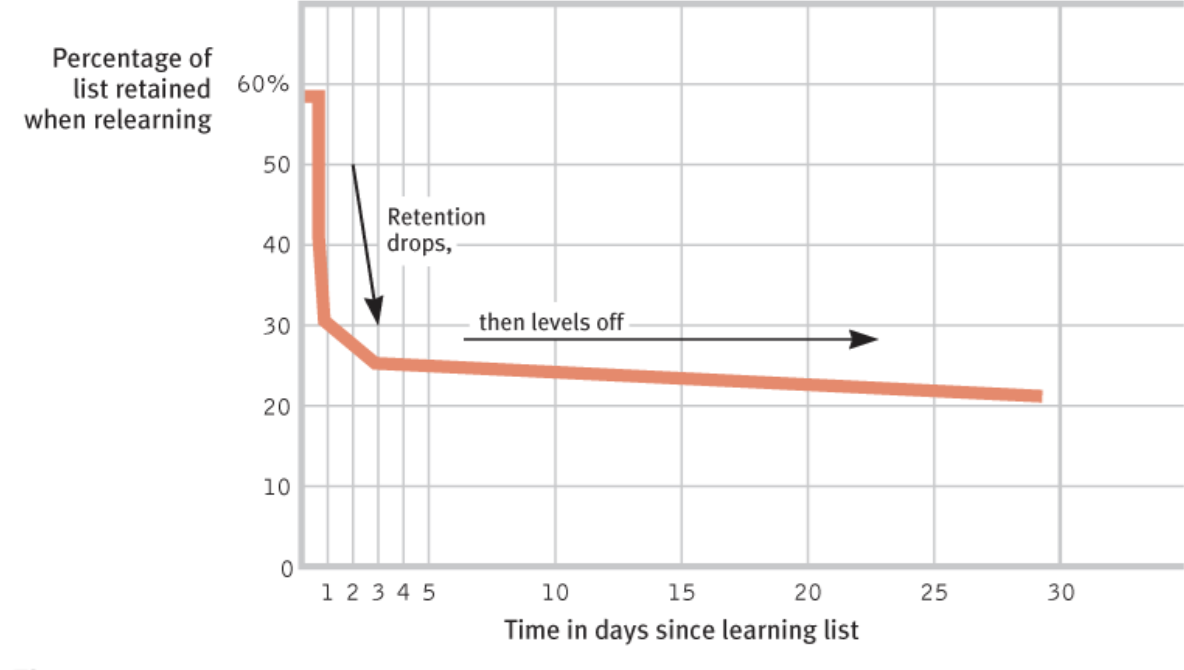
the forgetting curve states that forgetting generally happens rapidly after learning new information
however, this can be countered with reinforcement and review —> emphasizes the significance of distributed practice
tip-of-the-tongue phenomenon: when an individual knows a piece of information but is unable to think of the exact name
ex.) hearing a song, but being unable to recall the name
memory can be impaired by a multitude of ways
proactive interference: when older memories interfere with the recall of newer memories
forward acting
retroactive interference: new memories interfere with the recall of older memories
backwards acting
repression: pushing unpleasant thoughts, feelings, and memories into the unconscious mind to avoid distress
ex.) repressing embarrassing memories and being unable to recall them when asked
psychodynamic theorists believe that memories and information can be repressed to defend the ego from distress
will still influence emotions and behavior, appearing in dreams and therapy
defense mechanisms allow the ego to protect itself and reduce anxiety
generally focus on unconsciously distorting reality
constructive memory: when we remember information, the brain combines actual stored information with elements such as assumptions, expectations, and new information
reconsolidation: the process of altering memories that have been recalled before being stored
misinformation effect: if an individual does alter a memory with misleading or false information it can distort the memory
2.8 Intelligence and Achievement
no one set way to measure intelligence
intelligence: the ability to learn from experiences, adapt to new situations, solve problems, and apply knowledge in a variety of different contexts
is intelligence a general ability (g) or is it comprised of multiple abilities?
if people perform well in one area, they tend to perform better in another vs. intelligence not being a single trait, but distinct skills like emotional intelligence, creativity, and practical problem-solving
cohort:
fluid intelligence: the ability to quickly reason and breakdown abstract problems
decreases as an individual ages
crystallized intelligence: the accumulated knowledge and verbal skills an individual possesses
increases as an individual ages
individuals with a fixed mindset believe intelligence is a trait one is born with and it cannot change, potentially limiting an individual
individuals with a growth mindset believe intelligence can be developed through effort and experiences, leading them to seek growth opportunities
early intelligence tests introduced the concept of an intelligence quotient (IQ)
IQ = mental age/actual age x 100
IQ tests have since evolved and are no longer based on one’s mental age, instead they compare an individual’s performance to others in the same group using a standardized scale
socio-culturally responsive: minimize bias and reduce negative impacts in IQ tests
stereotype threats: an individual may feel at risk for confirming negative stereotypes about their social group
stereotype lift: an individual benefits from positive stereotypes about thei social group
in order for IQ tests to be relevant and beneficial to an individual they must follow the psychometric principles:
reliability: the test produces consistent results each time it is administered
test-retest reliability: refers to the consistency of test results over time when the same individual takes the test again
split-half reliability: refers to the consistency of results within the test itself, such as comparing the results from two halves of the same test
there should be a high correlation between multiple sections of the same test, showing that the test is correlated with itself
validity: the extent to which a test or or experiment measures or predicts what it is supposed to
content validity: the extent to which at test inquires about the information or behaviors that are of interest of the test
construct validity: the degree in which a test can actually measure a specific trait or concept
this ensure the test accurately measures the specific concept or trait it is supposed to
criterion validity: checks to see if the test correlates with any outside variables or measures
if this is low, the test may not be valid
predictive validity: predicts future performance
can only be used when there is a large data set
used to accurately predict trends and patterns
standardization: allow tests to be administered in a consistent manner
procedures and testing environment must be the same for all individuals to reduce bias and have a fair comparison
flynn effect: the global rise in IQ scores is due to people having access to better education, economic stability, healthcare, nutrition, and learning resources
there is often more variation of IQ scores within groups than across different groups
groups could be based on race, gender, or socioeconomic status
these differences between grouped individuals are often greater than the average differences found when comparing an entire group to another group
individual differences within a group are more significant than the average differences between groups
achievement test: designed to measure what someone knows at a specific point in time
assess knowledge and skills one has already learned
ex.) an AP or IB exam
aptitude test: aim to predict how someone will perform in the future
measure one’s potential to learn new skills and succeed in certain areas
ex.) ACT or SAT